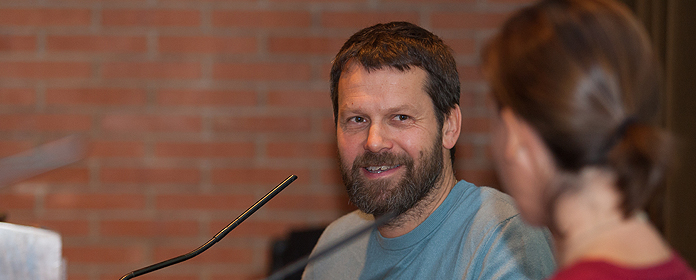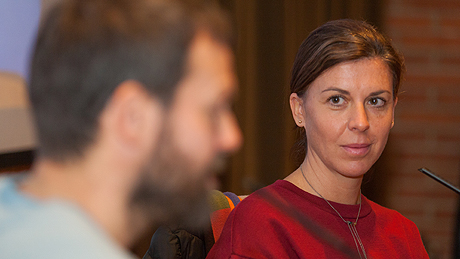A talk about design and its need to reinvent itself
Domitilla Dardi, from the MAXXI of Rome, and the designer Martino Gamper, in the School of Architecture

The custodian of the MAXXI museum in Rome, Mr. Domitilla Dardi and the Designer, Martino Gamper, spoke at the University of Navarra School of Architecture, about design and its need to reinvent itself
They met at the museum in Rome, were Mr. Gamper was showcasing “Transformer”, a work that changes the value of the objects through forms. A year later they meet again at our school talking about the designers most popular works.
Domitilla Dardi: Martino Gamper graduated in Vienna and took a master’s degree at the Royal College of Art in London under the direction of a leading designer Ron Arad. He has shown that in this discipline there are times when there is a division between craftsmanship and production. I think it is interesting for the students to learn how you started off as a designer.
Martino Gamper: It is exciting to be participating in this first year of the Design Degree here at the university and to show you “the students” how I got to where I am today. In the design industry one has to reinvent oneself with each project. You have to understand what you want to do because design is not the only thing in the world.
D: When you do not have a professional style to express yourself you have to try to investigate and know what is important for you.
M: For one of my projects, I went out to collect objects in the street. I found things that could work together. With this I made one hundred chairs and I made one chair per day.
D: Why did you challenge yourself in this way? I think performance was important during this project. I believe there has been jobs or works were you did not feel satisfied with the outcome of your work.
M: That’s true! For example, for this project, I had to design a new chair every day with a new idea. It did not always work.
D: Did you design it while working on it?
M: I mostly work out my designs on paper, but I have to test them first to see if they work, but the truth is that for me it’s much easier to design while working.
D: This is interesting, since you are bilingual, and don't need to be translating languages. Maybe this also happens when you are working. You usually transfer your ideas into something physical, perhaps because it is not a translation, but a transformation.
M: Yes. a lot of companies ask me to show them my latest works but I am always asking them what is it they need or want, and what the goal is for the project. It’s like writing a song or a book. There is no perfect chair, because it depends on the situation. Every day I try to mix and match different parts, to spread them and recreate.

▲ One of the window displays of Prada in Milan, designed by Martino Gamper
The frenzy of fashionMartino Gamper: One has to play a lot with the composition of the environment. the design is supposed to adapt to the environment in which it is in. It’s not the other way around. This I test out. For example, with the window displays for Prada in Milan. Through my composition I was able to give depth to the window using only wood.
Domitilla Dardi: As an artistic effect
M: Yes, and with this project I understood the fast pace with witch one has to design, to adapt to the faster pace of the fashion industry. It’s exhausting!
D: Like you said, it’s all about the rhythm. The fashion industry is very interesting and offers different opportunities. In fact, it is striking to see how much fashion has to contribute to the design industry. Sometimes both areas can go at the same rhythm, but other times the slower process in design has to be respected.

▲ Table with a mixture of wood by Martino Gamper
The Table tells storiesMartino Gamper: This wood comes from the ancient colonies, it probably has around 67 years, I was able to make it into a wonderful piece. I show this to other people when traveling to different counties.
Domitilla Dardi: So, let’s say that each wood tells a different story and together they just all make sense.
M: Exactly. That is why, in my designs, I seek to promote and draw what each wood has to say.
M: Sometimes, a design can represent the state of mind the author is in, like if it was made for you and only you. Even some works can be identified as yours, even without you having to sign it.
D: That’s true, I have seen collections that describe a psychological portrait. it is strange, because sometime I did not know who the author was but through his works I saw it reflected a very intimate vision of his thoughts.
M: Each one of us designs our lives in our own way. We have our words, thoughts and ways at looking at things, beliefs and feelings. This also happens a lot while being a designer.

